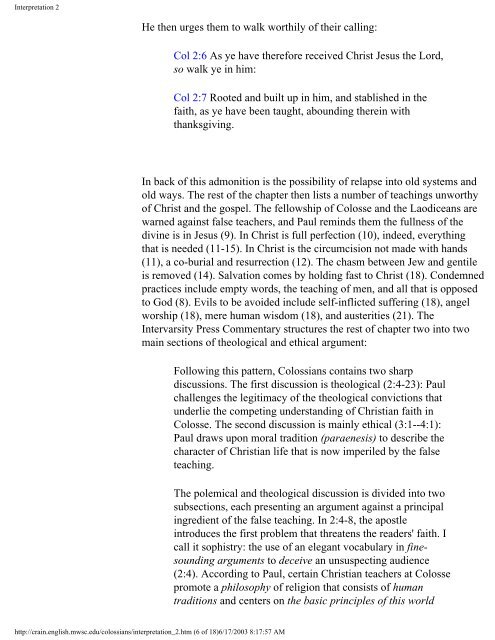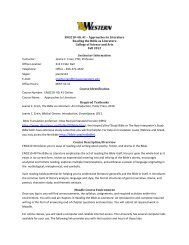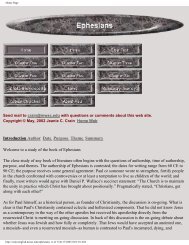Introduction to Colossians: Authorship, Date, Audience - Crain Home
Introduction to Colossians: Authorship, Date, Audience - Crain Home
Introduction to Colossians: Authorship, Date, Audience - Crain Home
You also want an ePaper? Increase the reach of your titles
YUMPU automatically turns print PDFs into web optimized ePapers that Google loves.
Interpretation 2<br />
He then urges them <strong>to</strong> walk worthily of their calling:<br />
Col 2:6 As ye have therefore received Christ Jesus the Lord,<br />
so walk ye in him:<br />
Col 2:7 Rooted and built up in him, and stablished in the<br />
faith, as ye have been taught, abounding therein with<br />
thanksgiving.<br />
In back of this admonition is the possibility of relapse in<strong>to</strong> old systems and<br />
old ways. The rest of the chapter then lists a number of teachings unworthy<br />
of Christ and the gospel. The fellowship of Colosse and the Laodiceans are<br />
warned against false teachers, and Paul reminds them the fullness of the<br />
divine is in Jesus (9). In Christ is full perfection (10), indeed, everything<br />
that is needed (11-15). In Christ is the circumcision not made with hands<br />
(11), a co-burial and resurrection (12). The chasm between Jew and gentile<br />
is removed (14). Salvation comes by holding fast <strong>to</strong> Christ (18). Condemned<br />
practices include empty words, the teaching of men, and all that is opposed<br />
<strong>to</strong> God (8). Evils <strong>to</strong> be avoided include self-inflicted suffering (18), angel<br />
worship (18), mere human wisdom (18), and austerities (21). The<br />
Intervarsity Press Commentary structures the rest of chapter two in<strong>to</strong> two<br />
main sections of theological and ethical argument:<br />
http://crain.english.mwsc.edu/colossians/interpretation_2.htm (6 of 18)6/17/2003 8:17:57 AM<br />
Following this pattern, <strong>Colossians</strong> contains two sharp<br />
discussions. The first discussion is theological (2:4-23): Paul<br />
challenges the legitimacy of the theological convictions that<br />
underlie the competing understanding of Christian faith in<br />
Colosse. The second discussion is mainly ethical (3:1--4:1):<br />
Paul draws upon moral tradition (paraenesis) <strong>to</strong> describe the<br />
character of Christian life that is now imperiled by the false<br />
teaching.<br />
The polemical and theological discussion is divided in<strong>to</strong> two<br />
subsections, each presenting an argument against a principal<br />
ingredient of the false teaching. In 2:4-8, the apostle<br />
introduces the first problem that threatens the readers' faith. I<br />
call it sophistry: the use of an elegant vocabulary in finesounding<br />
arguments <strong>to</strong> deceive an unsuspecting audience<br />
(2:4). According <strong>to</strong> Paul, certain Christian teachers at Colosse<br />
promote a philosophy of religion that consists of human<br />
traditions and centers on the basic principles of this world






![[38cb1273][0][sourcelist][1][0] - Crain Home](https://img.yumpu.com/2168350/1/190x245/38cb12730sourcelist10-crain-home.jpg?quality=85)